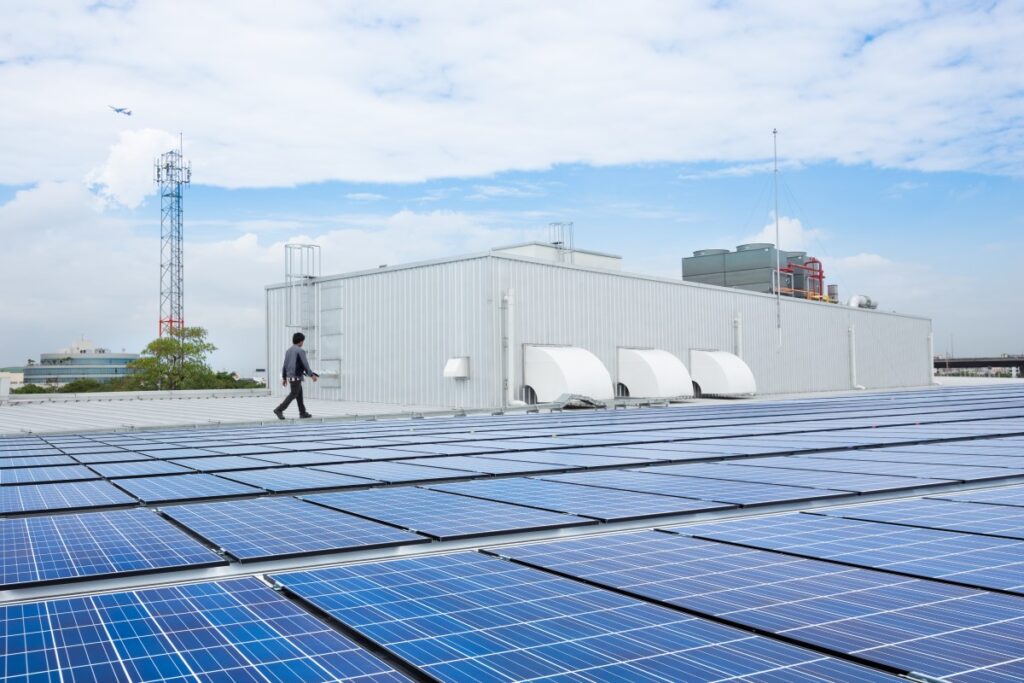This article appeared in the November/December 2020 issue of NAIOP-MD InSites Newsletter.
Developments in the solar energy sector have made the prospect of placing solar panels on the roofs of commercial buildings both more intriguing and more daunting.

The price of generating energy through photo voltaic (PV) panels has dropped 38 percent in Maryland in the last five years, making many solar installations financially attractive. Pricing and PV technology is expected to further improve over the next five years as Maryland encourages businesses to add 1.1 gigawatts in solar energy capacity to meet the state’s rising requirements for renewable energy production. Some legislators have even proposed making rooftop solar mandatory on certain commercial buildings.
Consequently, many CRE executives are looking to determine how to handle solar energy opportunities – and possibly requirements – successfully.
“The good thing about rooftop solar is it’s mostly found money,” said Stephen Luttrell, Counsel at Whiteford Taylor Preston, LLP. “It gives the commercial landlord an opportunity to monetize an asset they wouldn’t otherwise.”
CRE companies, of course, can offset utility costs for their buildings by installing their own solar arrays and generating electricity on their rooftop. Companies, however, can also bypass the sometimes complex financing involved in developing their own system and simply lease roof space to the expanding number of solar energy developers who are looking for sites to install arrays.
“It’s a pretty big and growing market in Maryland and D.C.,” Luttrell said. “In my experience of representing commercial real estate clients, they generally don’t have to go looking for developers who are interested in installing arrays on their roofs.”
Not every building is a suitable candidate. Solar arrays typically have a life cycle of 25 years, “so if your roof is 10 years old and has 10 years of life left, that is not a good candidate for solar,” said Jared Friedman, Vice President/Global Energy for Prologis. “You don’t want to put solar on a roof knowing that you are going to have to peel it off 10 years from now.”
The installation of PV panels alongside rooftop HVAC units, cellular towers and other equipment, especially in a multi-tenant building, can also complicate rooftop solar projects.
“You have to be cognizant of the coordination needed among tenants who access those systems, as well as the allocated risk and liability if something happens that causes a system shutdown or creates another problem,” Luttrell said. For example, “if an outside contractor servicing one of your tenants’ HVAC units damages an array, does your rooftop lease with your tenants address that issue? It can get complicated pretty quickly when you start looking at each individual tenant’s responsibilities and rights.”
Establishing business practices that manage those challenges, however, has its payoffs.
Solar adds value to commercial properties and helps attract and retain clients, said Friedman who, before joining Prologis this year, spent five years at REC Solar (a subsidiary of Duke Energy) developing solar energy projects for a variety of commercial real estate companies.
Prologis is currently expanding its rooftop solar installations through its Solar Smart program
“We spend all the money, put the solar on the roof and maintain it… The customer gets the savings on their energy bill,” Friedman said. Those savings are not enormous – often 3-10% of their energy bill. “But for a customer who spends $500,000 a year on utilities, you could save them $50,000 and they didn’t have to do anything to earn that money.”
The program, he added, enables Prologis “to generate more revenue from our building because we collect some additional roof rent.” It also enables Prologis and some of its tenants to advance corporate sustainability missions by deploying more renewable energy systems on sites that wouldn’t have been developed under previous business models.